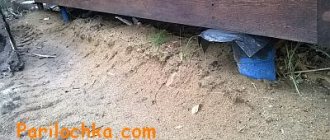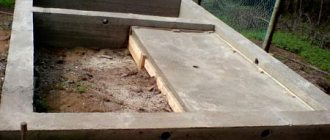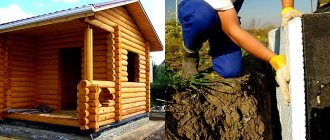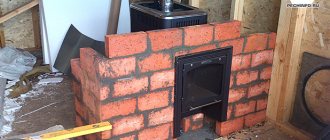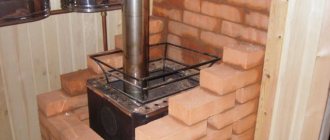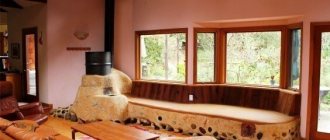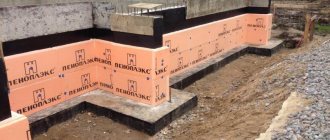Despite technological progress in the heating equipment industry, home furnaces continue to enjoy continued popularity. They allow you to heat houses in areas remote from civilization. Where electricity and gasification are not provided. The construction of any furnace begins with the construction of the foundation. We will talk about how to make a foundation for a stove correctly in this article.
Sectional view of the foundation for the furnace
Making a stove, of course, requires a lot of labor, experience and knowledge of technology. When thinking about building a stove at your dacha and building a foundation, you can, of course, hire specialists. But in fact, arranging the foundation for a furnace can be easily done on your own.
Home oven
This is not such a costly or complicated matter, but the pleasure from a self-built structure will more than pay for all the trouble.
Making a foundation for a metal stove with your own hands
Metal oven
If the stove is installed in an already finished house, where this device was not previously intended and wooden floors are already laid, then the construction of the foundation will have to begin with partial dismantling of the floor covering.
Foundation for a metal stove
- We mark the floor with a construction marker, depending on the size of the stove. The base should exceed the stove by 7-10 cm on each side.
- Using a grinder, we cut a rectangle into the floor.
- We dig a hole with a bayonet shovel 50 cm deep.
- Pour gravel and sand into the bottom of the hole, compact it tightly and pour in a little water.
- We create formwork from boards or sheets of plywood and lay 1 layer of roofing felt around the perimeter.
Formwork - Fill the pit with a solution of sand and crushed stone (for 4 portions of sand, take 1 portion of crushed stone). We do not reach the floor level by 10 cm.
- We level the mortar with a shovel and check the horizontal position with a building level.
- Technological break 2 weeks until complete hardening.
- We lay 2 layers of brickwork on top of the cement mortar, reaching the level of the finished floor.
As you can see, this is a simpler way to build a foundation, which does not require such careful preparation and laying of reinforcing mesh. The low weight of the metal structure of 150-170 kg does not require such a powerful foundation.
To avoid critical mistakes when building a foundation for a furnace, we recommend watching this video.
Strip type of foundations
Such a foundation will become indispensable on soils that have average mobility.
It is performed in almost the same way as its monolithic counterpart. The only difference is that this type is most often used in a wooden house. And it’s much easier to make a trench under it with your own hands than to dig a solid foundation pit for a monolithic type of base. The main work is carried out in the following order:
- Digging a trench 28-30 cm larger than the size of the base of the future furnace.
- Making a pillow from crushed stone and sand.
- Production of waterproofing and an even layer of the future bottom of the foundation.
- Creation of formwork and strengthening it along the entire perimeter of the trench.
- Reinforcement with rods or mesh.
- Filling with mortar or laying bricks (stones).
- Removing formwork.
Sometimes, in order to save cement mortar, owners line the trench with brick or stone, bonding the building material together using the same mortar. This is considered only a plus for the manufacture of the foundation, as it adds strength to it. But in a financial sense, laying out a pit or trench with bricks is very expensive.
Foundation for an iron furnace
Making a foundation for an iron stove is not difficult. Necessary:
- Dig a pit of a suitable size. The size of the foundation should be 10-15 cm larger than the dimensions of the stove (more is possible, less is not possible). If the metal furnace is built with a brick screen, then the indentation is calculated from the outer edge of the screen. The depth of the foundation and pit depends on the type of soil. On non-heaving soils, 50-60 cm is sufficient.
- Crushed stone is poured into the bottom and compacted thoroughly.
The compacted size of this layer must be at least 30 cm. Foundation for an iron stove - Compacted crushed stone is poured with liquid cement mortar. The approximate ratio of materials for its manufacture is as follows: take 4 parts of sand for one part of cement, the amount of water depends on the state of the solution - it should be of medium thickness.
- After the layer has dried (in a day or two), a waterproofing layer is laid. This can be roofing felt in two layers or one of the new bitumen waterproofing materials (roll or coating).
- The formwork is set according to the selected foundation dimensions.
- A layer of concrete is poured.
For one part of cement you need to take 2.5 parts of sand, 4 parts of fine gravel or expanded clay (with expanded clay you will get a more thermally insulated base). First, cement and sand are mixed dry until an even color is obtained. Then gravel or expanded clay is poured in and everything is mixed again. When all parts are evenly distributed, dilute with water. Water usually goes a little less in volume than cement. We carefully level the laid out solution, checking its horizontalness using a building level. The foundation for the stove can be covered with bricks: it looks more attractive this way - Instead of a concrete layer, you can use bricks. They are placed on a cement-sand mortar.
The formwork can be removed after three days, and the concrete gains its design strength in three to four weeks. For normal ripening, it must be regularly moistened with water: sprinkle generously 2-4 times a day, depending on the temperature. There should be no puddles, but the solution should get wet well. If it's too hot outside, cover the base with plastic wrap to prevent moisture from evaporating quickly.
There is a moisturizing option that does not require frequent spraying: cover it with burlap or some other fabric, add a good layer of sawdust, and wet it. This is enough for a day.
A concrete base is cheaper and stronger, but requires more physical effort, even if you have a concrete mixer. The disadvantages of concrete include the difficulty of dismantling it.
If the upper part of the base is cast from concrete, then outwardly it has an unattractive appearance. You can line the foundation with bricks from the outside, but this is only if conditions permit: the brick is still of decent size. For other cases, cladding with thick ceramic tiles (thick ones) is suitable. Porcelain tiles are likely to crack at high temperatures. Perhaps a natural finishing stone would be suitable.
The tiles are laid on a special heat-resistant glue (there are such). The grout is also selected accordingly - resistant to high temperatures. You can do without grouting: carefully open the seams with glue. If you do everything carefully, the appearance will be normal. The grout only looks good at first. Then, when ash and soot are added, you will be tortured to scrub it off.
What needs to be done before you start pouring the foundation...
First, be sure to analyze the density of the soil, especially if the brick kiln is planned to be large and massive. Usually there are no problems with sandy and clay soils. But if the soil is loose, heterogeneous and contains a lot of excess moisture, be sure to take measures to compact it before starting work.
Secondly, it doesn’t hurt to know the groundwater level. If they are located low, then the base is made 15 cm larger on each side than the stove itself, and is buried as much as required by the weight of the stove structure, as well as the degree of heaving of the soil. So, for example, on loam the base should be below the freezing level of the ground.
And if you are building a stove on sandy loam soil, there is no point in “burying” deeper than 80 cm. If the groundwater is located close, then the deepening of the foundation will be minimal, but its dimensions for greater stability are much greater than the dimensions of the stove.
Do-it-yourself foundation for a bathhouse stove
If the building is being erected on stable soil, the depth of the foundation for a brick oven can be from 0.7 to 1 meter. In this case, the base for the stove should be located approximately 30 cm below the bath floor. If you need to place the base of the stove flush with the floor, the top layer is laid out with refractory bricks in several rows.
The base for the stove can be made of concrete or cement-based rubble.
The installation procedure is as follows:
- Dig a hole along the width and length of the stove, allowing up to 10 centimeters on all sides.
- Pour sand into the bottom and fill with water. Wait until the water goes away and repeat all over again. The procedure is repeated until the sand finally settles. The final layer thickness must be at least 15 cm.
- Pour 20 cm of crushed stone/gravel. Instead of crushed stone, you can use brick scrap. Compact.
- Once again fill with sand and fill with water as above. Repeat until the sand settles.
- Another layer of gravel, 10 cm.
- Pour a cement-sand screed 5-7 centimeters high.
- Lay roofing felt.
- Install the formwork approximately 10 cm from the pit wall.
- Install the reinforcement cage.
- Pour concrete. The level is 15 cm below the ground. Level, tamp, deflate with a bayonet shovel. Check the level for horizontalness.
- After setting, remove the formwork.
- Lay roofing felt or roofing felt on top of the slab. Vertical walls can be treated with hot tar.
- Fill the space between the slab and the walls of the pit with ASG.
- Lay bricks without mortar, make outlets from metal corners, and perform fireproof cuts.
It is impossible to add concrete to a ready-made base; this can lead to uneven settlement of the stove. For the same reasons, the foundation of the stove is not connected to the main one. If the stove is located in a corner or near a wall and the foundations are located close to each other, a sand layer of about 0.5 meters is made between them.
Column/pile foundation for a sauna stove
- In the corners of the future stove, drill 4 holes for pillars with a cross-section of about 20 centimeters to the designed depth.
- Fill the bottom with a layer of crushed stone up to 15 cm and compact it.
- Insert rolled roofing material into the holes.
- Place a bundle of several reinforcing rods in each hole, each rod up to 8 mm thick.
- Pour concrete. Dry for at least 10 days.
- Place a reinforced concrete slab on the posts. Its width and length should be larger than the distances between the posts and larger than the corresponding dimensions of the stove.
If the mass of the stove is relatively small, instead of a reinforced concrete slab, you can use a sheet of asbestos or roofing iron.
Foundation for a steel stove or boiler
- Dig a pit.
- Fill with at least 30 cm of crushed stone and compact it.
- Make a footing using cement mortar of medium consistency. Dry overnight. Mortar proportions: 1 (cement) / 4 (sand).
- Lay roofing felt. Adjacent pieces are laid with an overlap.
- Fill the pit with concrete. Solution proportions: 1 (cement) / 4 (fine gravel) / 2.5 (sand).
- Check the horizontal level, level it, and bleed the air.
Place for the furnace
Choose the optimal location for the heating stove. For example, a stove installed in the center of the room will distribute heat as efficiently and evenly as possible. However, such placement of the stove is not always convenient.
Stove in the center of the room
If the stove structure is placed against the wall (this option is the most popular and frequently used), cold will flow across the floor of the house.
Select in advance the location of the combustion chamber door. Design the stove so that in the future you do not have to carry fuel throughout the room, spreading dirt around the room.
The heating stove is located against the wall
The best option is to install a firebox in a room that is rarely visited.
Recommendations regarding the foundation are standard - an individual concrete foundation is installed. It cannot be connected to the main foundation.
Calculate the design of the foundation in such a way that it is able to withstand the load not only of the furnace itself, but also of the smoke exhaust structure, which is also strongly recommended to be built of brick.
What are the features of installing a stove in an already built house and when does it need a separate foundation?
A country house without a stove or fireplace is like an orphan, deprived of comfort and warmth. Fire has an amazing attractive power, and the hearth certainly becomes a semantic center around which the entire space is organized. But it also happens that a stove or fireplace has to be built into an already finished building. What difficulties may arise in this regard?
We begin to pour the foundation for a brick oven with our own hands
Foundation for a brick oven
Step 1. Marking for the foundation and pit
- Once you have decided on the location of the future furnace, you need to correctly calculate its dimensions based on power. It depends on the area of the room, the number of doors, windows, etc.
- We draw the required size of the oven on the ground. The foundation should be 15-20 cm larger than the heating structure. Make markings and install pegs that will mark the boundaries of the pit for the foundation pit.
- Using a bayonet shovel, dig a hole 70-100 cm deep, depending on the density of the soil and the climate zone (see above).
- We lay a sand cushion 10-15 cm thick at the bottom of the trench. We compact it tightly with a shovel and pour a layer of medium-fraction gravel to a height of 30 cm. Pour a bucket of water onto the surface of the sand-crushed stone cushion and compact it tightly.
Step 2. Installation of formwork and reinforcement
- Let's start building formwork from boards. In principle, any old boards or plywood that you have on the farm are suitable for formwork. This does not in any way affect the technical properties of the foundation.
- The formwork is a wooden box, which, for reliability, is fastened at the corners with metal corners. Connect the boards together using nails.
- We lower the finished formwork to the bottom of the pit.
- After the pillow is firmly compacted, it is necessary to waterproof the base. To do this, we measure the size of the pit onto the polyethylene, cut it out and attach the polyethylene to the walls along the perimeter of the formwork using a construction stapler.
- Reinforcement of the foundation is necessary in order to give rigidity to the entire structure. We will reinforce with steel rods with a cross-section of 12 mm, which must be connected to each other by welding in the form of a frame or metal wire with a cross-section of 0.8 mm.
- The final work on the construction of the foundation is joining the floor to the foundation. It is better to do this by laying an even row of bricks.
Step 3. Prepare the concrete mixture for pouring the foundation
We prepare a mixture of the following proportion: for 4 parts sand, take 1 part cement + 3 parts crushed stone of the middle fraction.
Concrete mixer
Stir the dry mixture well with a bayonet shovel and add water. Mix the solution well using a concrete mixer. In consistency, it should resemble thick sour cream.
Preparing concrete solution
We fill part of the pit with this mixture, not reaching the level of the base floor by 8 cm. This work must be completed within 24 hours. The concrete solution should be complete and not layered.
Fill and wait 2 weeks
After you fill the entire pit with concrete, you need to once again check the horizontalness of the coating with a building level. After the solution has completely dried, it will be more difficult to correct your mistakes.
We check the levelness of the foundation with a building level
Cover the foundation with a layer of polyethylene or roofing felt and leave for 2 weeks until completely dry.
We remove the upper part of the formwork only after complete drying, beating the boards with a hammer. Pour crushed stone and sand into the resulting gap and compact it well.
Installation of formwork: construction and nuances
Work begins only after everything necessary has been delivered to the site. The foundation is built in such a way that it has a connection with the main base of the structure.
The most common options are when one of the parties unites with him. To begin with, it is worth making the markings.
Installation diagram of a columnar foundation for an iron stove.
- To carry it out correctly, you will need to remove all unnecessary things from the site. Next, using various measuring instruments, the contours of the future furnace are outlined. Then, according to the markings, a trench of the required depth is dug. All soil must be thrown into the middle of the building.
- A sand cushion is poured onto the bottom of the trench. Its thickness is approximately 12-15 centimeters.
- Next, the pillow must be moistened with water and compacted tightly. Formwork is installed along the outer and inner contours. Its top edge should be at the same level as the ground. Formwork panels are made from unedged boards. The boards are connected using nails and slats.
- It is necessary to lay waterproofing and thermal insulation on the pillow. Next comes the installation of fittings. It consists of steel rods, which are laid in a trench, two pieces each.
- You can connect the reinforcement to each other using welding, but a more effective method is to knit the rods with a special wire. To do this, you can purchase a hook at a specialized store, created specifically for such purposes.
Now you can begin the final stage of work, namely pouring the foundation.
Basic rules for laying a foundation
Whatever option you choose for the foundation for the stove, and whatever size you decide to implement, there are a number of basic rules that you should not ignore:
The foundation for the stove must be made independent, in no way connected with the foundation of the entire house. Why? The fact is that during operation, the house may shrink slightly. When lowering, it should not pull the stove along with it, as this can lead to its deformation, deterioration of draft and disruption of technical properties.
The foundation for the furnace is separated from the general one
In some cases, it is possible to partially combine two bases by connecting them with one wall.
- If both foundations (for the house and for the stove) are located close to each other, you need to fill them with sand 50 mm thick.
- If the foundation for a common house is strip, then the base for the stove should in no case be in contact with this foundation.
- When choosing a place for a stove and, accordingly, a foundation, you should not only rely on wishes, but also on factors such as: the location of doors, windows and roof beams. The location of the chimney should be taken into account so that the pipe does not fall into the ceilings and beams during the construction of the stove.
- When calculating the size and depth of the foundation, be sure to take into account the weight of the floors and the weight of the stove along with the chimney.
The size of the foundation is influenced not only by the dimensions of the furnace, but also by the density of the soil on which it is built. The main load in the furnace is usually created by the chimney, so when designing the furnace, it is necessary to place it closer to the center of the base. This will help avoid asymmetrical loading and premature incorrect shrinkage of the oven.
Sometimes, when designing a very large and massive stove with a stone chimney, stove makers create a separate base for the chimney.
Also, the choice of foundation depends on the material of the furnace. For a metal structure and a stone one, it will be different in depth; the entire mass of a brick oven is at least 400-500 kg, while a metal oven weighs approximately 150 kg.
How to calculate the weight of a stone stove
In principle, for a small metal stove you don’t have to build a separate foundation, especially if it is being built in a house that stands on a tiled monolithic foundation.
The density of the soil and the degree of its freezing play an important role in determining the size of the foundation. The climate in Russia is accompanied by fairly harsh winters throughout almost its entire territory. Therefore, the foundation for the furnace must be laid to the entire depth of soil freezing.
The type of soil is also of great importance.
Types of soil
It comes in three types:
- clay;
- sandy loam;
- loam.
In places where a large number of rivers, reservoirs, and lakes predominate, sedimentary types of soil are usually found. Here, it is better to entrust the construction of the foundation for the stove and the house to professionals, so calculations of the water passage point must be carried out.
In Central Russia, the most common type of soil is loam, which is a mixture of sand and clay. It is clay that predominates in it, so this soil is less plastic.
Loam
Building a foundation on such soil is usually associated with hassle and additional problems, since when dry the loam is crumbly, when frost sets in it begins to “heave”, and when there is a large amount of sediment it becomes viscous.
Clay soil
Therefore, in this case, the depth of laying the foundation for the furnace must be made above the freezing point.
But in forested areas, on the contrary, it is necessary to lay the foundation for the stove below the freezing point of the soil and the foundation must be built on a sand cushion 60-90 cm thick.
One of the most reliable types of soil for building a foundation is gravelly and rocky, but, unfortunately, sometimes you have to build a house and stove on an unstable one. Proper construction of a reliable foundation will help offset this fact.
In what cases is a foundation needed?
As mentioned above, the installation of structures must be accompanied by the construction of a base in the form of a foundation, with the exception of structures whose weight does not exceed 200 kilograms; in all other cases it is necessary.
Even light brick structures need a good foundation, due to the constant movement of soil and the general shrinkage of the house. And it’s not worth talking about massive, heavy, brick stoves - without a high-quality foundation, properly designed, they cannot survive in the modern climate.
Device stages
A foundation pit is dug for the furnace
At the initial stage of building a foundation for the furnace, it is necessary to dig a pit, the dimensions of which will exceed the sides of the foundation by 0.15 m.
At the same time, we remember that the foundation for the stove exceeds the dimensions of the stove by 0.05 m.
Those. the pit should be 20 cm larger on each side. The depth of the pit is dug taking into account the type of soil and the weight of the future furnace.
| Soil type | Foundation depth (m) | Type of mortar for masonry |
| Sandy | 0,5 | Lime |
| Rocky | up to 2 t – 0.25; more than 2 t – 0.4 | Lime |
| Bulk | to the level of dense soil | Lime-cement |
| Clayey | 0,75-1 | Clay-cement |
| Wet | up to 1 | Lime-cement |
We fill the bottom of the pit with crushed stone or coarse sand and compact it. At the exit there should be a layer of cushion of 0.15 m. After this, it is necessary to install the formwork. The formwork is made equal to the size of the foundation, i.e. less than a pit. A layer of waterproofing, for example roofing felt, is laid inside. The areas of the box are laid out, i.e. bottom and walls.
Rubble concrete piles will help save materials
The classic construction option involves reinforcement from a metal rod with a diameter of 12 mm. Depending on the thickness of the fill, the mesh is made in one level or three-dimensional.
The voids between the stones should be filled with fine crushed stone, and then pour everything with a concrete solution or mix the solution together with crushed stone and stone, evenly distribute the volume inside the formwork, compact and tap the formwork walls.
This method is suitable for constructing a foundation for a small brick oven.
When implementing it, the work of pouring concrete must be carried out in one time, in layers of up to 0.6 m.
Each layer is compacted using the deep vibration method. The upper level of the foundation for the stove should be 1 - 2 bricks below the floor level. With any method of constructing a monolithic slab for constructing the base of a stove in a house, two layers of roofing material are fused onto the top layer with mastic in a criss-cross manner.
- Content:
- Do you need a foundation for a brick stove? How to calculate the foundation for a stove
- Pile foundations
Light metal stoves are not suitable for everyone for heating a residential building or installing in a bathhouse. As practice shows, in every third case, stove equipment made of brick is chosen. The structure is installed on a solid foundation.
The foundation for the stove is made of brick, prevents destruction of the masonry, prolongs its service life. The strength and depth of the foundation are calculated based on the characteristics of the soil, the total weight of the structure and climatic conditions.
The preparation of the foundation is envisaged in the early stages of designing a residential building or bathhouse, even before the construction of walls. During preparation, the burial depth is calculated, and the type and material of the base is selected.
Advantages and disadvantages
Types of pile foundations are divided primarily according to the method of construction into driven, driven and screw. Each model of a structural element is characterized by its own characteristics.
The general advantages of all types of piles include the following:
- Applicability for all types of soils and reliefs of any complexity.
Where laying a strip or slab base would be ineffective or impractical, supports are used. Pile foundations can be built on unstable, waterlogged soils, areas at risk of landslides or flooding, wetlands, as well as on slopes and depressions. - Economic expediency. Laying single load-bearing elements connected into a single structure with strapping costs 30–40% less than constructing a slab or strip buried foundation.
- Possibility to select a power element for any conditions. The popularity of pile technology has led to an increase in offers from pile manufacturers. Today you can select supports with a load-bearing capacity from 0.8 to 15 tons or more, and composite elements are used for deep laying.
- Small amount of excavation work. If, in the case of a buried strip or slab base, it is necessary to dig a pit to the design depth, then to install cast-in-place piles it is enough to drill holes in the ground, and the driven and screw pillars are immersed in the soil by force.
Disadvantages of pile technology:
- Complexity of engineering calculations. Pile foundation technology can satisfy almost all hydrogeological and design conditions, but this will require a number of engineering calculations. Before designing, the designer needs to study the regulatory requirements for the construction of foundations in order to take into account possible nuances for each type of support.
- Labor intensity of work on arrangement of basements. It is possible to organize the construction of underground premises in the space between the power elements, but this will lead to a significant increase in the cost of the project, which will practically cover the benefits of using pile technology.
For a private home
Private residential buildings and cottages are relatively light in weight compared to high-rise buildings and industrial facilities. This feature allows you to abandon the laying of an expensive reinforced concrete strip or slab foundation in favor of factory-made or home-made piles.
Advantages of pile technology for private construction:
- the possibility of laying the foundation with your own hands (screw piles, cast-in-place piles);
- if necessary, methods are available to strengthen the foundation (when building extensions, increasing the number of storeys, replacing floors in a house, etc.);
- maintainability.
Why you should not build a private house on a pile foundation:
- significant heat loss due to the elevation of the house above ground level;
- labor-intensive procedure of engineering calculations;
- There is high seismic activity in the area.
Different types of piles
The choice of piles is based on the results of hydrogeological soil surveys, as well as engineering calculations for design loads. Comparative table of pros and cons for various types of power structures:
| Support type | Benefits of technology | Disadvantages of technology |
| Driven reinforced concrete |
|
|
| Driven steel |
| |
| Driven wooden |
|
|
| Bored |
|
|
| Screw metal |
|
|
| Screw reinforced concrete |
|
|
General information: materials and characteristics of heat-resistant concrete
Heat-resistant concrete is a special type of concrete material that can withstand temperatures in the range of +1580-1770C for a long time without loss of operational and mechanical properties (refractory concrete, in turn, can withstand short-term heating up to a maximum temperature of +200C).
Concrete is used in the construction of residential and industrial buildings. Fire-resistant and heat-resistant concrete is used to make barbecues, home heating stoves, saunas, baths, chimneys, fireplaces, etc.
Heat-resistant concrete can be structural and thermal insulating. The structure is light porous, dense, cellular.
Composition of dense fire-resistant mortars
Dense heavy heat-resistant concrete (the composition may be different) is usually used in the creation of fire-resistant structures, as well as in the form of heat-resistant lining in certain thermal units: in the chemical industry, blast furnace recuperators, in special brick kilns, in the process of building chimneys pipes
Knitting
Heat-resistant concrete is produced in accordance with GOST 20910 90. This document assumes the possibility of using various binders in the preparation of the solution.
Types of binders for production:
- Liquid glass
- Aluminous (this can also include high-alumina) cement
- Portland slag cement with special microfillers
- Portland cement with the obligatory inclusion of a microfiller (finely ground additive) in the composition
In a neutral/alkaline environment, a mixture of Portland slag cement and Portland cement is usually used. Liquid glass is suitable for acidic gas environments. For hydrogen, phosphorus, and carbon environments, it is better to choose alumina and high-alumina cements.
Fillers
Refractory concrete involves the introduction of not only special binders, but also the right fillers, which must expand evenly and thus withstand the effects of fire and high temperatures. Ordinary fillers guarantee resistance at a maximum of +200C, then they become less durable and at +600C they are completely deformed.
When refractory concrete is prepared, the composition involves the use of a material as fillers that will not collapse/soften at high temperatures, and will not cause high stresses to appear in the internal structure of the monolith.
Selecting aggregate according to temperature:
- +600 – 800С: rocks (diabase, andesite, basalt), porous materials from volcanic rocks, this can be granulated blast furnace slag, broken bricks, artificial porous structures (expanded perlite, expanded clay, slag pumice is suitable, etc.) .
- +1200 – 1700С: crushed refractory materials are added – chromite, fireclay brick, magnesite, corundum and burnt kaolin are often chosen.
- It is possible to add special materials obtained by firing at a high temperature a mixture of refractory clay and magnesite - aluminosilicates, which are characterized by minimal deformation and good fire resistance.
Technical requirements
The grade of fire-resistant concrete should include the following parameters:
- Type of concrete: heat-resistant is indicated by the letters BR
- Binder: aluminate (A), Portland cement (P), silicates (S)
- Compressive/tensile strength class – B1-B40
- Operating temperature – IZ-I18
As for density, a material with an index of 1100 kg/m3 is used as thermal insulation for unloaded enclosing structures, >1400 - for the construction of enclosing load-bearing structures of public/residential buildings. According to the level of maximum temperature, concrete can belong to one of 18 classes: I13-I18 are used only for non-load-bearing structures.
If the density of concrete is 1500 kg/m3, it must have a water resistance in the W-W8 range. Frost resistance is at the level of F-F75. Residual strength and deformation temperature indicator under mechanical load directly depend on the type of binders and the exact heating temperature.
As for the strength class, for stressed heat-resistant structures the indicator should be at least B30, without load - a minimum of B12.5 is allowed.
Arrangement of a concrete base
The foundation for a concrete-based Russian stove is created using the following materials and elements:
- Cement. If the soil contains a large amount of sulfates, sulfate-resistant cement of the SSPTs brand is best suited.
- Sand. You need a coarse-grained type without inclusions; mountain sand is the best choice; river and sea sand are also suitable.
- Formwork.
- Crushed stone.
- Waterproofing layer. Ruberoid would be a good choice.
- Container for preparing construction mixture.
- Bayonet and shovel shovels.
- Level for measurements.
- Hammer, nails and construction stapler.
Concrete foundation for a furnace Source hozsektor.ru To build a high-quality foundation, you must carefully follow all instructions. The procedure consists of the following steps:
- Marking, digging a pit and filling it with sand and gravel.
- Arrangement of formwork and installation of reinforcement.
- Pouring concrete solution.
Digging holes and backfilling
The first step is to decide on the location of the stove, based on its size, the volume of the house, the number of windows and doors. The approximate dimensions of the structure are indicated on the ground. The base should be approximately 20 cm larger than the heating device. Pegs are used to mark the boundaries of the pit.
After which a trench is dug. It should be deeper than the soil freezing level and 100 mm wider than the base. Thanks to this backlog, it will be possible to avoid the consequences of possible soil movement. For dry sandy soils, the pit depth should be about 80 cm, for heaving types - at least 1 m.
Then a pillow is placed at the bottom of the hole. First, a layer of sand about 15 cm thick is poured and filled with water. When the water evaporates, add a small amount of sand and add water again. After which crushed stone and small stones are laid, the thickness of this layer should be 20 cm. The pillow is compacted, then sand is poured back in and water is poured in. The action must be repeated until the sand stops settling.
Installation of formwork and reinforcement
Formwork is installed along the perimeter of the trench. To do this, you can use old boards or sheets of plywood; the material will not affect the functionality of the structure in any way. Supports must be installed at intervals of 50 cm. It must be taken into account that there must be a free space of at least 10 cm between the formwork and the soil. At the corners, the structure is fastened with metal staples. The boards are fastened using nails.
The finished formwork is immersed in the bottom of the trench. Then you will need to waterproof the base. For this, polyethylene is used; it must be stapled around the perimeter to the formwork. Next is reinforcement. This will ensure the rigidity of the entire structure. Reinforcement is performed using steel rods with a cross-section of 12 mm, which are fastened together by welding or wire. At the end you will need to connect the floor to the foundation. To do this, you need to lay out an even row of bricks.
Concrete foundation diagram Source karelia-dom.ru
Pouring concrete
To make a concrete solution you will need: 1 part cement, 3 parts stove, 5 parts crushed stone and water. All ingredients are thoroughly mixed, while water is added gradually. For mixing, it is best to use a concrete mixer; the consistency of the composition should resemble sour cream.
Before pouring, it is recommended to moisten the formwork so that the wood does not absorb moisture from the solution. After which the composition is poured in layers of 20 cm. Each layer must be beaten to get rid of air in the solution. The entire pit is gradually filled. The upper part of the foundation is leveled and covered with polyethylene or roofing felt to ensure protection from external influences during drying. Drying will take at least 3 weeks, during which time the foundation must be constantly moistened.
The final procedure will be the dismantling of the formwork. The empty space between the soil and the base will need to be filled with gravel and coarse sand.

